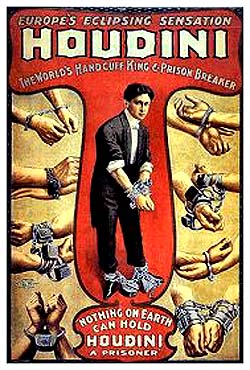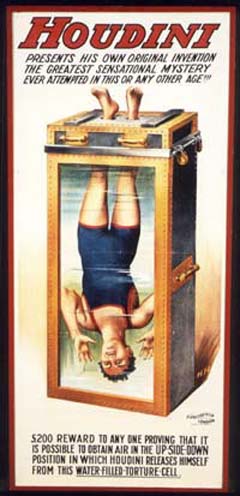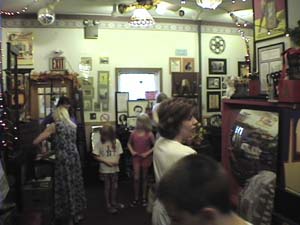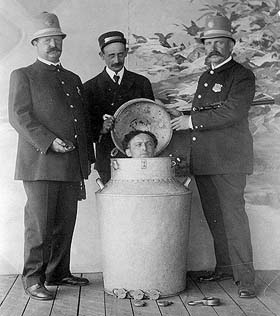Houdini
Lives! (Or
at Least He Does in Scranton, PA)

Houdini worked
at becoming the greatest escapologist in history.
|
My youngest son has long been fascinated with magic,
so last summer I decided it might be interesting to take the family
on a day trip to somewhere with a magical theme. I'd seen a brochure
for a museum that seemed to fit the bill, so we packed everybody
into the car one day and headed up the Northeast Extension of
the Pennsylvania Turnpike to Scranton: a four hour trip.
The brochure was for the Houdini Museum.
Now if you are not sure who Houdini was, don't feel too bad. He
died over eighty years ago. When he was alive, however, he was
probably the biggest, and certainly the most well paid, entertainer
of his era. He didn't sing or dance and what little acting he
did was a sideline. What Houdini did, however, and did well, was
magic. His specialty was dangerous escape stunts.
Ehrich
Weiss
Born in Hungaria in 1874 under the name Ehrich Weiss,
Houdini moved with his parents to Appleton, Wisconsin, when he
was four years old. According to his autobiography he started
his show business career at age ten as a trapeze artist, under
the moniker: "Ehrich, the Prince of the Air." By 1894 he was working
as a professional magician, having taken the name Houdini in honor
of the French magician Jean Eugène Robert-Houdin. Within a few
years Houdini realized that the most popular part of his act was
his escape from handcuffs and he decided to concentrate on becoming
the greatest escapologist that ever lived. It isn't hard to argue
that he succeeded.
Houdini was particularly known for dangerous acts
involving water. The first of these was the "milk can" escape.
Houdini would have himself locked in an oversized milk can overflowing
with water with the idea that he would have only the time he could
hold his breath to get free, or die.
|

Houdini's
most famous trick was probably the dangerous Chinese
Water Torture Cell.
|
Later, after many other magicians had copied the
milk can trick, Houdini invented The Chinese Water Torture
Cell which he took pains to have copyrighted so competitors
couldn't steal his idea. His feet were placed in stocks and he
was hung upside-down then lowered into the cell which was filled
with water. The front of the cell was glass so the audience could
see him in the giant tank for at least the first part of the trick
as he started his escape.
Spiritualism, the supposed communication with the
dead through a sensitive person (known as a medium) was popular
in this era and Houdini also spent much of his time exposing psychic
frauds. His understanding of the use of magical illusion help
him debunk spiritual cheats where scientists often failed. Despite
this opposition to spiritualism, however, Houdini managed to maintain
a friendship for many years with Sir Arthur Conan-Doyle, a noted
spiritualist and author of the Sherlock Holmes stories. Conan-Doyle
was so amazed by Houdini's tricks that he was convinced the magician
could dematerialize himself and reappear somewhere else at will.
The
Scranton Connection
I had pictured the Houdini Museum as sort of a modern
building in a little park-like area with perhaps a huge picture
of the master of magic out front. Instead, the directions seemed
to take us into a residential section of Scranto, one of the older,
less maintained sections to boot. The address was 1433 North Main
Ave. We checked each block as it went by 1200…1300…1400…1500.
Oops, we must have missed it. I turned the car around and when
back. About mid-block we saw it. A large, older house converted
to a business. There was indeed a portrait of Houdini painted
at the second floor level, but with most of the building's original
windows boarded over, the place tended to look more like a liquor
store at the ground level than a museum. My wife took one look
at the place and seemed doubtful, the kind of look I know that
means "…you dragged us three hours up the turnpike for this?"
|

The
interior of the Houdini Museum.
|
A sign out front directed us to park in back. I
pulled around the block then behind the building via a rear street,
well, really an alley, and into the rear parking lot, which admittedly
appeared more like somebody's back yard. My wife seemed more doubtful
than ever. Despite this we lined up at the rear entrance to wait
the ten minutes or so for the museum to open. While we were standing
there listening to a tinny speaker play music from the 1920's,
another family lined up behind us. That made me feel a lot better.
At least my wife couldn't claim I was the only father to drag
his family here…
The door opened right on time and a woman took our
money, than started a tour of the house. The building was certainly
full of Houdini memorabilia - posters, props, personal items owned
by Houdini. They even had one of the milk cans Houdini used for
his escape act. The tour guide invited the group to hold their
breath as she talked about the can to see if any of us could match
Houdini's ability. He was reputed to be able to hold his breath
for over four minutes. I am a man of few skills, but one thing
I excel in is holding my breath. After a good two minutes plus
- fifteen seconds longer than any one else in the group - I finally
gave in, unable to equal Houdini's performance. Still, for having
the best lung capacity in the tour group I won a prize: a fingernail
file emblazoned with the museum's slogan Houdini Lives! I treasure
it even today.
With the museum tour over we were ushered into a
room at the front of the house that had been converted to a small
theater. Our guide now changed to a man with a mustache that introduced
himself as Dick Brooks. Mr. Brooks showed us some video about
the museum and gave us its history. You might wonder what connection
Scranton has with Houdini. After all he was born in Hungaria and
spent his early years in Appleton, Wisconsin (later, Houdini -
in a feat of legerdemain worthy of such a magician - would mysteriously
change his birthplace to Appleton). Appleton has a Houdini historical
center, which makes sense, but where is the connection with Scranton?
Well, Houdini did play Scranton on several occasions, but the
museum location stems not from the master magician so much as
from one of his fans. Brooks' father followed Houdini's career
closely acquiring any props, letters and posters associated with
him that he could. The museum was founded upon this collection.
|

Houdini
enclosed in a overflowing milkcan. Was this the one in the
Scranton Museum?
|
The third part of the Houdini experience was a show
performed live on stage. Our tour guide from earlier magically
transformed herself into Dorothy Dietrich, a nationally-known
illusionist. Dietrich, along with Brooks, heads up the museum
and performs there on a regular basis. Dietrich (like Houdini)
is noted for tackling potentially-dangerous tricks like catching
a bullet in her teeth and dangling from a burning rope while escaping
from a straight jacket. Dietrich did neither of these at the museum
that day - thank goodness - but did do an impressive show of legerdemain
my family and I enjoyed.
For the final portion of the day Brooks returned
under the guise of Bravo the Great! to demonstrate some of the
tricks available in the museum's shop. Brooks is a magician of
some note himself and for a number of years he and Dietrich ran
New York City's Magic Towne House before setting up the Houdini
Museum.
Mysterious
Death
Houdini died under mysterious circumstances. The
story has it that McGill University student, J. Gordon Whitehead,
went to Houdini backstage asking if it was true that Houdini could
take any blow to the stomach. Houdini said it was and Whitehead
punched him three times before the magician had time to prepare.
Two days later, at the Garrick theater in Detroit, Michigan, on
October 24, 1926, Houdini did his last performance and was hospitalized
after the show with a ruptured appendix. He died a week later
on Halloween. For many years Whitehead was blamed for his death,
but modern medical analysis suggests that Houdini's appendix problem
preceded the attack, but one has to wonder if the pain from the
blows masked the appendicitis.
|
Did Spiritualists
Kill Houdini?
There has long
been a rumor that Houdini didn't die of a ruptured appendix,
but was poisoned by some spiritualists in revenge for the
frauds he was exposing. While there seems little hard evidence
to support this, in 2007 George Hardeen, whose grandfather
was Houdini's brother, filed papers with the court to have
the magician's remains exhumed and tested. Hardeen admits
that even if something is found there is little that can
be done eighty years later "except set the record straight."
"It's a curiosity
to me, just as it is to anyone else" he said.
|
Always fearful that psychic frauds would claim they
had heard from Houdini beyond the grave, he had worked out a secret
code with his wife. Though a séance was held each year on Halloween
night following his death, no coded messages were ever received
from Houdini. After a decade his wife announced that "ten years
is long enough to wait for any man" and discontinued the yearly
affair, though other magicians , including Dietrich and Brooks
at the museum, still keep alive the tradition of holding a Halloween
séance in remembrance of Houdini.
The Scranton museum's collection is one of the few
places where actual props used by the master magician can still
be seen by the public. Houdini willed most of his materials to
his brother,Theodore Hardeen, who was also a magician, so Hardeen
could continue to use them with the understanding that they would
be "burned and destroyed" upon the brother's death, therefore
concealing Houdini's secrets forever. Hardeen, however, decided
to sell them to collector Sidney H. Radner instead. Some of the
best pieces from Radner's collection were displayed at a Houdini
Museum at Niagara Falls until a mysterious fire in 1995 destroyed
most of the props. One can only wonder if this was the master
magician finally reaching out from beyond the grave to have his
will fulfilled…
Currently, admission to the Scranton museum is $12.99
for adults, $9.99 for children. For that you get hours of entertainment
and a very worthwhile afternoon. There is something special about
seeing people doing what they love and it is obvious that Dietrich
and Brooks love magic and being caretakers of the Houdini collection.
It makes the museum more than just a building filled with old
props. It makes it a building filled with, well...magic.

Copyright 2007 Lee Krystek.
All Rights Reserved.